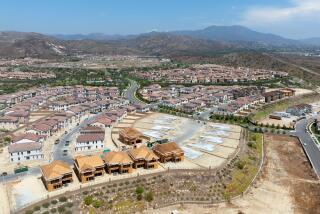In Riverside County, Housing Market Shows Definite Signs of Slowing
Last fall, houses in Forecast Homes’ Hidden Meadows subdivision in the southwest Riverside County community of Menifee were starting in the mid-to-high $400,000s.
These days, prices are starting in the high $300,000s.
In nearby Murrieta, Shea Homes Co. is giving some buyers in its Blackmore Ranch development $10,000 in flooring upgrades and discounts on closing costs if they finance through the firm’s mortgage unit. Last year Shea offered no such incentives.
A year ago, eager customers of Van Daele Development Co.’s Stoneridge development in Menifee camped out to make sure they would win spots on the prospective buyers’ list. Today there are no lines -- and Van Daele has lowered the price on certain units.
Southern California’s hottest housing market is experiencing a bit of a frost.
Riverside County, along with neighboring San Bernardino County, has long been a sweet spot for the nation’s home builders. With its burgeoning population and relatively low land costs, the Inland Empire has been one of the steadiest and fastest-growing markets in California.
In the last three years, the median price for new and resold homes in Riverside County has soared 55%. Strong demand has been a lever for builders to crank up prices: Until recently, they had only to build out one phase of a project before they could turn around and raise prices $20,000 or more on every house in the next phase.
The Inland Empire “is not as much of a slam-dunk market as it used to be,” said Peter Dennehy, an industry consultant and senior vice president of Ryness Co.’s Sullivan Group Real Estate Advisors in San Diego.
Just ask D. Sidney Potter. Having realized profits from selling other recently built homes in the Inland Empire, the Los Angeles real estate investor bought two houses in Forecast’s Hidden Meadows community in September. He paid $471,999 for a 3,000-square-foot model and $461,240 for a slightly smaller one.
After Potter signed the purchase documents, Forecast started advertising the same models for $27,000 and $34,000 less, respectively.
“Some of the Inland Empire builders, not just Forecast, got ahead of the market at the end of last summer when properties weren’t moving as fast,” said Potter, who described his Hidden Meadows investments as adding up to “paper losses at this time.”
He’s trying to get the company to refund the difference. So far, the two sides are at an impasse. And the company has since altered its purchase policy to keep short-term investors at bay.
Forecast Group Vice President Michael Dwight characterized the price reductions as incentives that kept the company competitive.
Since September, price gains in parts of the Inland Empire have contracted and sales have shrunk.
In southwest Riverside County, for instance, the rate of increase in the median price of a new single-family home declined 8 percentage points from the second quarter of 2004 to the fourth quarter. And in the last three months of the year, new-home sales plunged 54% compared with the same three months in 2003, according to Hanley Wood Market Intelligence, formerly known as Meyers Group.
“The frenzy is over, or at the very least there’s a slowing,” Dwight said.
“Slowing” might be the best descriptor, because it’s not as though houses are actually getting cheaper. The median price of a new single-family home climbed throughout 2004. In the fourth quarter, that price was 33% higher year over year, at $483,990.
Still, at the first hint last fall of resistance to rising prices, builders became more aggressive about getting people to sign on the dotted line. “They need to retain their sales volume, so they quickly responded to the softening,” consultant Dennehy said.
Experts have long warned that the home-selling supernova in the Inland Empire would eventually cool, as it has elsewhere in Southern California.
“There’s no way ... we will continue seeing what we’re seeing,” because even typically affordable areas are becoming less so, said economist and industry consultant John Husing.
It wasn’t surprising that southwest Riverside County was among the first areas to feel the chill, he said, because it’s primarily a bedroom community serving San Diego, where home prices started cooling nearly a year ago.
The fact that the supply of new homes continues to swell has contributed to the softness in pricing. Currently, 294 projects are seeking buyers in the Inland Empire, 50% more than a year ago, according to Ryness. In Riverside County along the I-215 corridor leading to San Diego, billboards touting new subdivisions far outnumber signs for fast food or cellular phone service.
No one is warning of an oversupply crisis of the kind that foreshadowed the housing bust in the early 1990s. Then, builders rapidly expanded throughout Southern California, whether they had buyers lined up or not. This time, companies are careful to have buyers lined up before construction begins.
In Ryland Group’s Eastridge community in Menifee, the paint had barely dried before “For Sale” signs started popping up throughout the neighborhood. Late last month, nearly two dozen “For Sale” placards could be counted -- many in front of houses purchased by investors who never moved in.
Even so, the Ryland sales force is working to boost interest in the next phase of Eastridge, where homes are being offered in the high $300,000s to low $400,000s, less than the listing prices of many of the first-phase Eastridge resales.
The Calabasas-based home builder, which just reported its sixth straight year of higher profit, offers incentives of about 3.2% to 3.5% of the sales price and has changed its contracts to prevent investors from buying properties and quickly reselling them, spokeswoman Marya Jones said.
“Our strategy is to build stable residential communities,” Jones said.
For homes in the $300,000-to-$400,000 range, demand remains steady, observers said.
Daniel Oppenheim, a building industry analyst for Banc of America Securities, has been surveying local real estate firms to gauge market dynamics. He found that demand at the lower price range was still accelerating, although builder incentives increased 78% in December.
“We recognize that one month does not make a trend, but we believe this bears watching, as higher incentives generally suggest slowing market conditions,” he wrote recently.
Husing, for one, believes that even with any slowing, home prices in the Inland Empire will rise by double digits again this year -- but closer to 10%.
And many builders are optimistic. Centex Homes -- ranked sixth among Inland Empire builders in market share -- just plunked down $18 million for a 10-year lease to double its office space in the heart of the region because of expansion plans in southwest Riverside County and adjacent communities.
More to Read
Inside the business of entertainment
The Wide Shot brings you news, analysis and insights on everything from streaming wars to production — and what it all means for the future.
You may occasionally receive promotional content from the Los Angeles Times.










